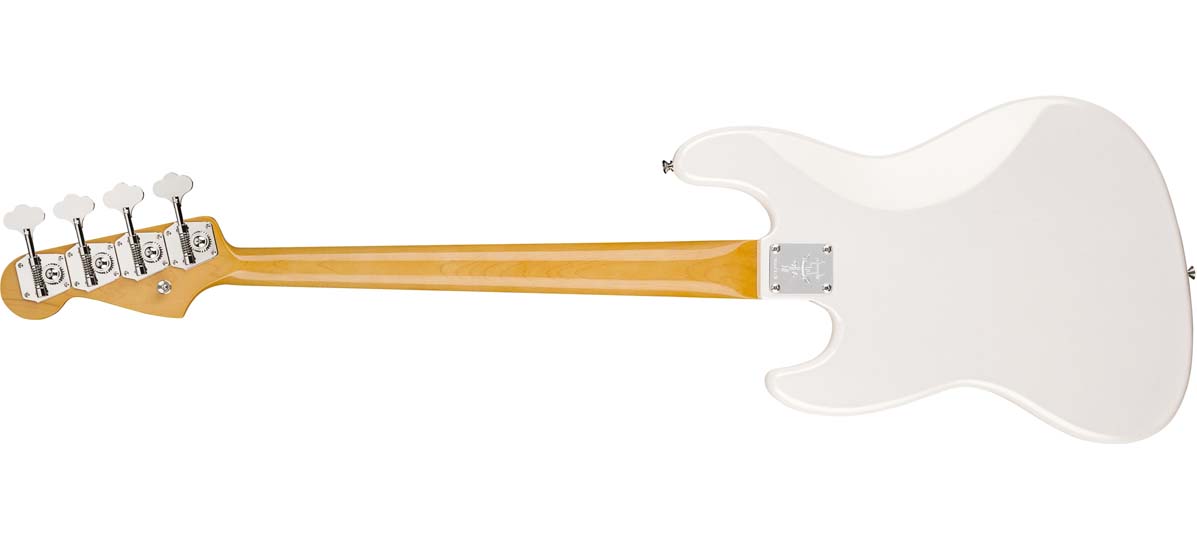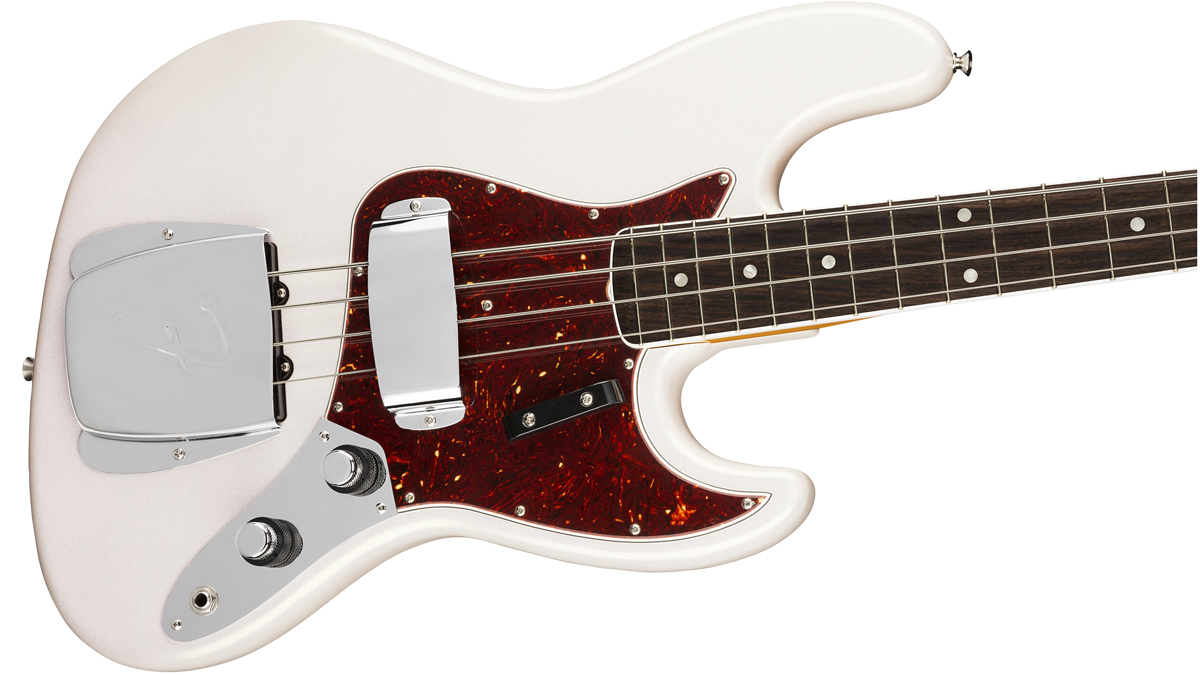Guitar World Verdict
Stellar sounds and style, worth the extra expense, the 60th Anniversary Jazz Bass doesn't set out to replicate a vintage model but rather gathers together some of the classic spec for a supremely well made bass that proves why the design has lasted the test of time.
Pros
- +
Tonal variety.
- +
Outstanding playability.
- +
Meticulous build.
- +
Classic looks.
Cons
- -
Unnecessary pickup covers, tug bar, and headstock strap button.
You can trust Guitar World
The Fender Jazz Bass is celebrating its 60th birthday this year, but it isn’t making any retirement plans soon, as it remains as vital, popular, and essential as ever. In celebration of this milestone, Fender is offering the 60th Anniversary Jazz as a limited production run.
This commemorative model is not a reproduction of any particular vintage Jazz, but rather a hybrid of sorts that combines several features from throughout the Sixties. Could this be the bass guitar for the '60s-style J-Bass aficionado?
Build Quality
Two features that prominently draw attention are the Arctic Pearl gloss nitrocellulose lacquer finish on the body and headstock face, and the pair of concentric control knobs. The finish exudes a silver glow under low light, with sparkling metallic flakes catching the eye under brighter spotlights.
The stacked concentric volume and tone knobs for each pickup – a beloved, but short-lived configuration that initially lasted from the model’s 1960 debut until late 1961– provide a wider range of tones than the volume/volume/tone setup that replaced it.

The knurled dome knobs for the volume controls turn with a smooth silky feel, while the black knurled outer-ring tone controls click into 11 distinct positions.
Closer examination reveals Sixties-style pickup placement where the Pure Vintage ’62 Single-Coil Jazz Bass pickups are positioned 3.5 inches apart, with the bridge pickup placed further away from the bridge than the Seventies-style positioning.
The dot-inlay rosewood fingerboard has single-ply binding – a feature introduced in 1965 – and the four-saddle Vintage-Style bridge has threaded steel saddles that facilitate custom string spacing.
Other period-correct details include a finger rest, or ‘tug bar’, mounted below the G string, a third strap button on the back of the headstock, and Pure Vintage reverse open-gear tuners with small clover-shaped keys.
One major historical exception is that individual adjustable felt string mutes and the later-style mute inside the bridge pickup cover are missing... not that anyone is going to miss them.
Befitting an instrument in the $2,000-plus price range, the construction is immaculate. The Vintage Tall frets are smoothly rounded and polished with no protruding or sharp edges, and the slots for the 1.5-inch-wide nut are filed to ideal widths and depths to firmly anchor the strings and maintain solid tuning without binding or pinging when adjusting tuners.
The neck pocket is airtight, providing optimal neck-to-body contact for sustain and dynamic response. Even a .001-inch feeler gauge couldn’t fit between the neck and body joint.

Sounds And Playability
Thanks to its '60s-style U-shape profile and 7.25-inch radius, the neck feels notably rounder and heftier than most modern necks, but it still maintains the slim, slinky feel and fast playability that has made the Jazz a favorite of flamboyant bassists from Larry Graham, Jaco, and John Entwistle, to Geddy Lee, and Flea.
The Vintage Tall frets are a good complement to this rounder neck style, providing accurate intonation and ample contact surface for bending notes. I noticed very little difference in playing feel between these frets and the wider, flatter frets on my ’71 Jazz.
A bigger issue for modern players is the pickup covers and tug bar that limit and inhibit right hand playing positions, but this problem is easily fixed in a few seconds with a screwdriver.
The alder body, maple neck with rosewood fingerboard, bone nut, steel saddles, and stock .045-.105 gauge nickel-plated steel strings all combine to deliver an alluring combination of low-end punch, growling mids, treble bite, and full-bodied sustain.
Having individual tone controls for each pickup is a huge advantage over the more-common post-1961 master tone circuit
The Pure Vintage ’62 Single-Coil Jazz Bass pickups with resistance measuring 7.11k ohms (bridge) and 6.41k ohms (neck) enhance these attributes with crisp articulation, detail and low noise, particularly with both pickups at full volume – where they deliver true humbucking performance.
Having individual tone controls for each pickup is a huge advantage over the more-common post-1961 master tone circuit, allowing bassists to tame the bridge pickup’s bite by backing down its tone slightly while maintaining the full-on bark of the neck pickup with its tone at full treble.
Even better is backing down the neck’s tone for a deep, round wallop, while keeping the bridge bright to maintain percussive attack ideal for slap playing that packs extra punch.
Conclusion
The 60th Anniversary Jazz is a worthy celebration of an instrument that truly changed the role of the electric bass. For players who prefer '60s features it’s the ultimate greatest hits package, but it also offers impressive tonal variety and playability to please more modern stylists.
Specs
- PRICE: $2,199.99 / £1,999
- MADE IN: USA
- BODY: Alder
- NECK: Maple, 34” scale, gloss nitrocellulose lacquer finish
- NECK JOINT: Bolt-on, four-bolt attachment Nut Width | 1.5” / 38mm
- FINGERBOARD: Rosewood
- FRETS: 20, Vintage Tall
- PICKUPS: Fender Pure Vintage ’62 Single-Coil Jazz Bass x 2
- ELECTRONICS: Passive
- CONTROLS: Volume/Tone Neck, Volume/
- Tone Bridge (concentric)
- HARDWARE: Nickel-chrome hardware, four-saddle vintage-style bridge with threaded steel saddles, Pure Vintage reverse open-gear machine heads
- WEIGHT: 9.6 lbs
- CASE/GIGBAG: Commemorative deluxe hardshell case
- LEFT-HANDED OPTION: No
- CONTACT: Fender
Chris is the co-author of Eruption - Conversations with Eddie Van Halen. He is a 40-year music industry veteran who started at Boardwalk Entertainment (Joan Jett, Night Ranger) and Roland US before becoming a guitar journalist in 1991. He has interviewed more than 600 artists, written more than 1,400 product reviews and contributed to Jeff Beck’s Beck 01: Hot Rods and Rock & Roll and Eric Clapton’s Six String Stories.
“It holds its own purely as a playable guitar. It’s really cool for the traveling musician – you can bring it on a flight and it fits beneath the seat”: Why Steve Stevens put his name to a foldable guitar
“Finely tuned instruments with effortless playability and one of the best vibratos there is”: PRS Standard 24 Satin and S2 Standard 24 Satin review













